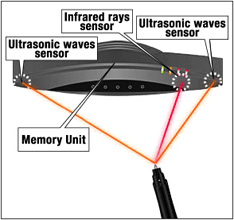Kids Web Japan
Web Japan > Kids Web Japan > Hi-tech > Digital Pens
Hi-tech
Digital Pens
Now you can input data to your computer with pen and paper!

©Pentel Co., Ltd.
There are several ways to convert handwritten contents into data, such as the ultrasonic method and the Anoto method. The ultrasonic method transmits both ultrasonic waves and infrared rays with the pen tip—and the pen's movement is traced by measuring the lag between the times when the two types of signals reach a receiver. The simple mechanism of this method, involving just a digital pen and a receiver with no special paper, makes it very convenient and easy to use.
Have you ever heard of digital pens? They are ballpoint pens that transform handwritten words and drawings into digital data. They have a built-in electronic circuit which transfers whatever you write on paper to a PC, and saves it. These revolutionary pens have eliminated the old, conventional need to scan sheets of paper to convert the contents into electronic data.
Digital pens are already being used around the world, from Japan to Europe to the United States. In Japan some corporations are finding ingenious ways to develop unique products by combining their own advanced technologies with digital pen technologies.
The unique digital pen, 'airpen' was developed with expertise in conventional writing material manufacturing technologies

©Pentel Co., Ltd.
Its convenient portability has helped popularize the airpen Mini, whose storage notebook fits into the palm of your hand.
Pentel Co., Ltd., a Japanese manufacturer specializing in stationery products, uses the ultrasonic method for its digital pen, the airpen series. The company made the most of the know-how it had acquired during more than 60 years of designing writing instruments with a stress on writing comfort. It also made the most of an input pen technology that it had employed to inscribe characters and drawings on screens in a print sticker machine it had once manufactured.
After a development period lasting a year and a half, Pentel released a unique digital pen that compares favorably with normal ballpoint pens in terms of grip comfort and writing smoothness. Its ease of use, very similar to ordinary ballpoint pens, is attracting growing numbers of purchasers among housewives, students and other general consumers, and among business people too.
Now there are highly creative, versatile writing systems incorporating digital pens
Dai Nippon Printing Co., Ltd., has made use of the digital pen incorporating the Anoto digital writing method to create system products such as OpenNOTE, an electronic notebook for classroom use, and the OpenSTAGE electronic blackboard. Anoto Digital Pen and Paper technology works by remembering what has been written or drawn on paper with the unique, almost invisible Anoto dot pattern, and transmits this data back to a PC or server. The digital pen writes like a normal ballpoint pen, but has a tiny infrared camera at its tip. Any paper can be used with a digital pen if the Anoto dot pattern is added to the layout before printing.

©Dai Nippon Printing Co.,Ltd.
Dai Nippon applied special printing technologies it uses to produce wallpaper—as well as other building materials that involve printing on large sheets and require high friction resistance—to the printing of dot patterns on electronic blackboard screens. It also drew on its long years of experience in systems development for corporate clients to create the software necessary to convert handwritten contents into accurate data. In other words, it combined technological capabilities cultivated for other purposes with digital pen technologies to create products with new added value.
The conversion of information of all kinds into data is progressing rapidly today, as organizations strive to promote work efficiency and solve environmental issues. Still, a unique handwriting culture remains deeply rooted in Japan. And the digital pen, which combines the advantages of handwriting and data conversion, has untapped potential for further development.

©Dai Nippon Printing Co.,Ltd.
Answers written on special paper with a digital pen by students using an OpenNOTE electronic notebook are immediately displayed on their teacher's PC. The system, which contributes to innovative classroom instruction in which everyone can participate enthusiastically, is already in use in 37 of educational institutions, from elementary schools, to junior-high and high schools, to universities.

©Dai Nippon Printing Co.,Ltd.
Since its special sheeting screen can be rolled up, the OpenSTAGE electronic blackboard is easily portable. Educational or other materials displayed on the screen can be directly overwritten on the screen with a digital pen, and the overwritten data can be saved as well. If you print educational materials on special paper, you can do the same thing. The capability of both teacher and students to write on the screen directly or by means of the paper, energizes classes and makes them more rewarding.
©Pentel Co.,Ltd.©Dai Nippon Printing Co.,Ltd.©Anoto Group AB
(Updated in March 2010)